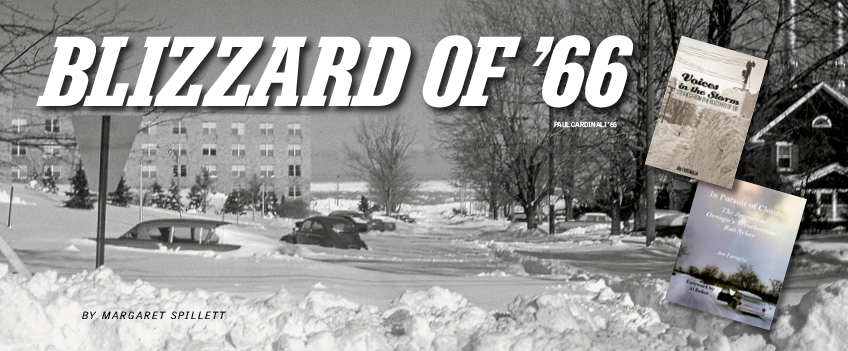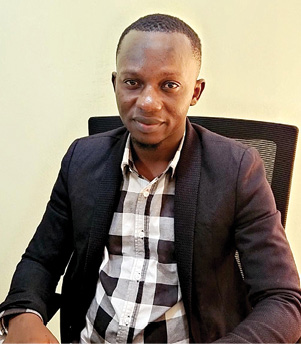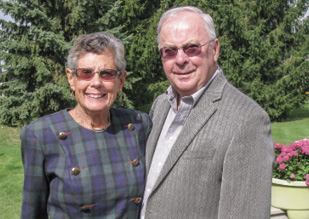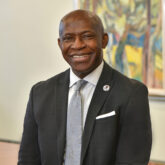Preface:
The artist’s life began early for Alice McDermott ’75. She was always writing, creating stories, as children do, as a means of shaping and controlling her world. At a very young age, she was in love with short stories and novels, in love with fiction.
Here’s Alice. She is filling page after page with her own fictional stories. She is keeping a series of notebooks. She is, at 12 or 13, completing a novel on loose-leaf portfolio paper.
Does she think she can be a writer? No.
“Writing was something other people could do,” McDermott says.
“It was a secret thing that nobody ever said could be done by someone like me, a middle-class girl from Long Island.”
 The Josephite nuns who taught McDermott and the other girls at Hempstead’s Sacred Heart Academy in the late 1960s provided them with a comprehensive reading experience that extended even beyond the school year. The renowned SHA summer reading lists were comprised of six or seven books with reports due the first week of school.
The Josephite nuns who taught McDermott and the other girls at Hempstead’s Sacred Heart Academy in the late 1960s provided them with a comprehensive reading experience that extended even beyond the school year. The renowned SHA summer reading lists were comprised of six or seven books with reports due the first week of school.
Here’s Alice. She is reading Jane Austen, the Brontë sisters, Melville and Dickens. She is reading Seventeen and the Saturday Evening Post. She is reading Jacqueline Susann and Leon Uris.
Does she think she can be a writer? No.
“I was a totally indiscriminate reader,” McDermott recalls. “I read the classics and the commercial blockbusters as well as all the good and bad fiction in magazines of the day. But it still felt as if becoming an author was a distant, almost sacred thing.”
High school graduation loomed, and, long past the point at which a certain nun should have stopped giving academic advice, she told the girls of Sacred Heart not to go to “one of those public colleges, where the boys and the girls are all put together.”
Here’s Alice. She, rebelliously, ignores the nun’s advice and chooses SUNY Oswego, where her love of reading inspires her to take English classes.
Does she think she can be a writer? Well … yes.
“In the fall of my sophomore year, I was studying nonfiction writing with Dr. Paul Briand,” she says. “It was one of the wonderful moments in my life. Dr. Briand told me, ‘You are a writer.’”
At the pinnacle of a literary career that has garnered her some of the most prestigious awards in letters, Alice McDermott ’75, author of seven literary novels, and dozens of short stories and articles, values her foundational experiences as a student at SUNY Oswego. She says it is at Oswego that the affirmation from English department faculty members helped her recognize for the first time that she could be part of the American literary tradition.
An avid reader and creative writer from childhood, McDermott grew up as a storyteller, and at her all-girl high school, her writing found an appreciative audience in her peers.
“We had a lot of assemblies, and every assembly had a skit,” she recalls. “I liked to write them, and by my junior and senior year, I was known as the go-to girl for skit writing.” Still, although she was expecting to go to college, she was not intending to pursue a degree that would lead to a career as an author.
When McDermott applied to SUNY colleges, Oswego became a top choice. Her older brother was enrolled nearby at Syracuse University, and the family saw the logic of Alice having rides to Central New York for a couple of years. At first considering a major in sociology, McDermott later decided on a degree in English.
“Oswego is where I learned about the craft of writing, where thoughtful professors were concerned about how students could be taught to be better writers,” McDermott says.
Professor Emeritus Lewis Turco, founder of Oswego’s English Writing Arts program, recalls McDermott as an excellent student, a serious writer. “But she was Briand’s from the start. She knew she wanted to write fiction,” he says.
Epiphany
McDermott’s epiphany in Dr. Briand’s Nature of Nonfiction class, when he declared her “a writer,” stems from the first assignment. He asked students to write an autobiographical essay, and McDermott told a story of something that happened to a first-person narrator. She wrote with the pronoun “I.” What happened to the narrator had not, however, happened in real life to McDermott. Thus, a short story was born.
She recalls sitting in the large lecture hall while Dr. Briand used an overhead projector to display her text on the screen, as he did with all student work. She recalls seeing her words scrutinized, her commas deleted, her sentences shaped. She recalls that when he finished, he said, “McDermott, I want to see you after class.”
It was then, after class, that Dr. Briand made his declaration: “Well, I have bad news for you kid. You’re a writer, and you’ll never shake it.”
A university teacher herself—she was appointed in 2002 as a professor at Johns Hopkins University—McDermott now takes advantage of opportunities to encourage student writers as she was encouraged at Oswego. She says Briand’s affirmation in that long-ago class was transforming.
“It was so generous and kind of him to tell me that,” she says. “It was as if I had just been waiting to hear it. Coming from a respected writer, from an innovative teacher, it meant everything to me.”
Learning Technique
In the early 1970s, beginning to believe that she could become an author, McDermott focused on literature and creative writing courses. Her undergraduate work was so strong that faculty members selected her in 1975 to receive the James E. Moreland Award, given to the outstanding senior in literature.
“Oswego was innovative,” she says. “It was uncommon to have so many options within the English degree. I took workshop classes in nonfiction and poetry, but it was my second class with Dr. Briand, a tutorial, that shaped my future as a novelist.”
Tutorial classes were limited to five students who never met as a group but, rather, wrote independently and met individually with a professor.
McDermott recalls those sessions like this: “I’d go in and meet with Dr. Briand, my draft in hand. He’d take it. He’d begin to read aloud. He’d stop. ‘Why that detail?’ he’d ask me. ‘Why a yellow dress? Why not a red dress?’ If I hedged, if I said I just picked the color randomly, he’d say, ‘You have a choice in every word. You make every detail say what you want to say.’”
Having declared all that, Dr. Briand passed along one more golden nugget: “And when you have said it, stop.”
Literary Style
Briand’s advice to “stop” might be the defining characteristic that has shaped McDermott’s oeuvre. Her writing is spare, sensuous and densely constructed. In a review of Someone (New York Times, Sept. 6, 2013) Leah Hager Cohen observes, “Such is the crisp purposefulness of McDermott’s prose. Her sentences know themselves so beautifully: what each has to deliver and how best to do it, within a modicum of space, with minimal fuss.”
McDermott says her work “assumes a certain confidence in the reader.” Thus, it is not for everyone.
“My writing asks a lot of the audience,” McDermott says. “Not every reader is looking for this kind of fiction. I am aware, always, of the agreement between the reader and the writer. Dr. Briand nurtured that in me.”
In terms of technique, McDermott says she is always conscious of her choices as a writer. “Will you, as a writer, pay attention to each sentence?” she asks. “The art and the architecture of each sentence is something Dr. Briand taught me to see.”
He also was the person who urged McDermott toward the graduate writing program at the University of New Hampshire and connected her with the legendary advocate of process writing, Donald Murray.
College Life
McDermott says her Oswego experience was, academically and socially, more than she expected when she chose a public school. She lived in Onondaga Hall for two years, then she took a year abroad at the University of Nottingham with 15 others.
“We became students in the British tradition while there,” she says. “For the entire year we studied only one subject: literature.” Upon her return for senior year, McDermott discovered she had met the maximum number of credits she could accrue in the English department. She was especially disappointed to face graduation without having taken a class from Turco.
“I appealed to Professor Turco, and he arranged for me to receive a ‘dispensation’ so I could take his poetry class in my final year,” McDermott says.
“The most wonderful thing about being an English major at Oswego?” she asks, then answers her own question: “I got a full background in literature there, including two wonderful Shakespeare seminars. From Beowulf and Edmund Spenser’s The Fairie Queen, right up to the works of Faulkner, Fitzgerald and Hemingway, I learned about the literary tradition I was secretly hoping to join.”
Dr. James Perdue was president when McDermott was a student. In those days, students registered in the gym, standing in line and moving up to the table to sign in. Reaching the front only to find the class had just filled was cause for groaning, but McDermott also recalls the festive atmosphere of the experience.
 “In the fall, it was like a big reunion,” she says. “We were all eager to see one another, and we could just feel the excitement of being back on campus, of being together again.” She recalls ducking inside from the howling wind and snaking in line across the muddy floors to register for spring semester.
“In the fall, it was like a big reunion,” she says. “We were all eager to see one another, and we could just feel the excitement of being back on campus, of being together again.” She recalls ducking inside from the howling wind and snaking in line across the muddy floors to register for spring semester.
Missing the large shopping malls of home, downstate students adjusted to commerce in Oswego. “We’d walk or hitchhike into town,” McDermott says. “We went to Green’s five and dime to pick up things for our dorm rooms. We bought Christmas presents at a little gift shop run by a retired Oswego English professor. We made good use of the sub shops. The bank on Bridge Street gave a hardcover dictionary to any student who opened an account. I still have mine. And, of course,” she adds, “on weekends we were at Buckland’s or Broadwell’s. In the spring, we were at Nunzi’s.”
McDermott recalls students of that period, when the legal drinking age was 18, also frequented the Rathskeller, a tavern downstairs at Hewitt Union. Designed and built by students, it included multiple seating levels, professional-grade stage and sound, murals and a bar.
In the SUNY Oswego tradition, McDermott and many of her classmates maintain their campus friendships. Four couples with Oswego connections will travel to Italy this spring.
One of the couples, Jim and Mary Ellen Lisiak Ryan, can thank McDermott for their romance; she introduced them at Broadwell’s. Doris Miele Caliguri ’75 and her husband, Frank, will be on the trip. She recalls being the only Italian girl hanging out with “a bunch of Irish kids.” On St. Patrick’s Day, she simply became “Dotty O’Miele.” Unable to condense 42 years of friendship into a few sentences, Caliguri says, “The Oswego legacy is still being formed.”
A birthday plaque from McDermott hangs in the home of Elizabeth Evans Corcoran ’76, who, with her husband, John, will join the Italy excursion. It says: I like you … you knew me when I was young and stupid.
“That plaque about sums it up,” Corcoran says. “I clearly remember the day of senior awards. I was sitting with Alice when she was recognized as the outstanding senior in the English department. I never would have known it from Alice. She always seemed ready to party. Those were the days.”
Recalling the undergraduate revelry and the good lives they’ve shared since graduation, McDermott says, “We have been together through dating, engagements, job hunts, weddings, births, joys and troubles. We are Oswego friends for life.”
The Artist
While authors don’t generally attain celebrity status, McDermott, with the positive reviews of her work and the high-profile awards she has earned, comes close. Her fourth novel, Charming Billy, has been printed in 57 editions in seven languages, and is held by 3,358 libraries worldwide. It won the American Book Award and the National Book Award.
Her novels have been included on the New York Times bestseller list, shortlisted for major prizes, including the Pulitzer, and reviewed positively. In spring 2013, McDermott was inducted into the New York State Writers Hall of Fame, along with literary luminaries Walter Mosley, Marilyn Hacker and Calvin Trillin.
“Deborah Stanley came to Manhattan for that,” McDermott says, “and it pleased me tremendously—so generous of her. Other recipients were impressed that my college president had come to celebrate with me.”
President Stanley says, “I was delighted to represent the students, faculty and staff of Alice McDermott’s alma mater in a celebration of her longstanding success as a writer. She has touched so many people through her memorable stories and characters and is an inspiration to our students.”
The hall of fame honor came just a few months before the publication and promotion of McDermott’s seventh novel, Someone, which resonates with the protagonist’s ongoing quest to understand the ordinary events and their consequences in her life. Details are revealed in spiraling waves of time that carry the reader from Marie’s childhood in the immigrant neighborhood where she lives with her parents and saintly brother, to her dignified acceptance of the burdens and blessings of age.
As the Richard A. Macksey Professor for Distinguished Teaching in the Humanities at Johns Hopkins, McDermott conducts writing seminars and conveys to students many of the same principles she acquired at Oswego.
“There is something wonderful about working with students, being reminded that the struggle is the same every time,” she says. “It’s good to be reminded, and it’s also good to be the one to cheer new writers on, to say, ‘There is good material in there. Let’s work to find it.’”
Having completed the book tour for Someone —“The biggest distraction to writing is to publish a book”— the author focuses on her next project.
“When I’m working,” she says, “I try to approach it as if I have a regular job: just keep a routine, just give it time. Write and write. Write more than I need.”
Recalling an incident from a women’s seminar in Los Angeles, when her oldest child was 2 and she was obviously pregnant with a second, McDermott says the novelist Diane Johnson gave her advice.
“Diane told me to put the children on the school bus in the morning, go to the kitchen table and—she illustrated this advice with a dramatic sweep of her arm—clear everything off the table and sit down to write. She told me that way, I’d get in a day of writing. And when the children came home, I could pick it all up and do the dishes,” McDermott says.
“While raising three children, I learned to take whatever time I could get to write.”
Those three children are now adults, pursuing their own passions. The elder son, at 28, is a jazz pianist in New York City; the daughter, 25, is a visual artist and a curator of performance art in D.C., and the younger son, 20, a student at Fordham, plays traditional Irish music. McDermott’s husband is a scientist at the National Institute of Health.
Only Rufous, the family’s 11-year-old labradoodle, poses a possible distraction. But his call for daily walks suits the author. “When I’m at my desk, eight hours can go by before I realize it,” she says. “It’s nice to have Rufous to remind me to go out and get some fresh air.”
If You Can Do Anything Else
In a Sept. 11, 2013, essay for “The 6th Floor,” a blog of the New York Times Magazine, McDermott relates three incidents in which successful writers are dispirited—by critics, by the press and by the pressures of producing their next success. She concludes with this advice, which she offers her students: If you can do anything else, kids, do it.
“I tell my students, if you can do anything other than pursue this literary fiction thing and still sleep at night and wake joyful in the morning and know that the hours of your days have been well spent, then you should do that – that other thing.”
McDermott says the advice clarifies what she—like other artists—knows deeply. She can’t do the other thing.
She has known since her sophomore year at SUNY Oswego the inevitability of her vocation, the certainty of her calling.
Here’s Alice. She is a writer.
1975
B.A. SUNY Oswego
James E. Moreland Award, outstanding senior in literature
1978
M.A. University of New Hampshire
1982
A Bigamist’s Daughter
1983
Oswego Alumni Association Distinguished Alumna Award
1987
That Night
Finalist: Pulitzer Prize, National Book Award, PEN Faulkner Award, Los Angeles Times Book Prize
1992
At Weddings and Wakes
Finalist: Pulitzer Prize
1993
Honorary Doctor of Letters, State University of New York
1998
Charming Billy
National Book Award
1999
American Book Award
Finalist: Dublin IMPAC Literary Award
2002
Child of My Heart
Appointed Richard A. Macksey Professor, Johns Hopkins University
2006
After This
Finalist: Pulitzer Prize
2008
Corrington Award for Literature
2008
Morgan Writer in Residence, University of North Carolina
2010
F. Scott Fitzgerald Award for Literature
2011
D’Angelo Scholar-In-Residence, St. John’s University, N.Y.
2013
Inducted into New York Writers Hall of Fame
2013
Someone
Semi-finalist: National Book Award
2014
Finalist National Book Critics Circle Award
You might also like
More from Alumni Profiles
Astrophysicist, Yale Professor Credits Oswego with Setting His Course for Stellar Career
Astrophysicist, Yale Professor Credits Oswego with Setting His Course for Stellar Career Earl Bellinger ’12 is one stellar guy. A quick review …
BHI Alumnus from Liberia Gains World of Experience
BHI Alumnus from Liberia Gains World of Experience Otis Gbala M’23 became the first SUNY Oswego graduate who studied from Liberia …
Couple’s Loyal Support for Oswego Spans Five Decades
Couple’s Loyal Support for Oswego Spans Five Decades Marilynn “Lynn” Nagy Farrar ’61 and Neil Farrar cherish their memories of Oswego …




















